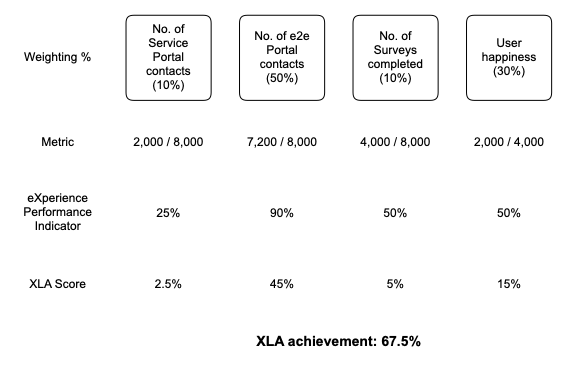Inside an XLA
 Steven Godson
Steven Godson
Greetings!
This week we will be diving deeper into what an XLA (eXperience Level Agreement) should be and look at some examples.
If you are not familiar with XLAs then my previous article XLAs - avoiding watermelons give a useful introduction.
An XLA is a combination of objective and subjective measures that give you a balanced measurement of the impact of the service, with a weighting towards how the “users” experience the service. So let’s look at some examples of what that means in reality.
Balanced Measurement
Objective and Subjective
An objective measure is based on data derived, usually, from the systems or toolsets that are used to manage either ITSM processes, e.g. Incident Management tools, or IT systems, e.g. Application Performance Management.
The objective measures, that help to make up an XLA, are important because they bring context and meaning to the subjective measures.
For example, if you have an XLA that is measuring user satisfaction with your Service Desk, then objectively measuring the number of contacts with the Service Desk gives context.
The context is important because if your subjective result shows 50 negative responses then this sounds, on the face of it, to be a bad thing. Now this result is never a “good” thing but, when taken into the context of 20,000 contacts in the Service Desk in a measurement period, thus meaning a 0.25% negative response, it doesn’t sound so bad.
But, is this really an accurate measure?
Again the answer revolves around context. If 20,000 contacts result in 20,000 survey responses, your subjective source, then this could well be a valid measurement. However, this is unlikely to be the case.
So, another objective measure would be the number of survey responses received in your measurement period. For the sake of novelty let’s say you get 420 completed surveys. Now this changes your perspective quite significantly.
Your original 0.25% becomes 11.9%, which is quite a dramatic change and suddenly things don’t seem quite so good.
However, what cannot be emphasised enough is that XLAs are for driving improvement in areas that are important to the business to that the service(s) are being delivered.
An XLA is neither a carrot to reward a service provider, nor is it a stick with which to beat one. An XLA is a point on the horizon that both customer and supplier are walking towards together. The measurement points are simply there to identify whether they are walking forwards, standing still or are walking backwards.
Source: Steven Godson
So, what we have, so far, is a number of objective measurements, which are as follows.
Total contacts to a Service Desk
Total number of survey results and as a % of total contacts
Total number of positive/negative survey responses and their respective percentages
So, what’s next? Well, the next thing is to define what good” actually looks like in your context and ensure balance in your results.
What is “good” anyway?
What good means, in the context of XLAs, will greatly depend on what you are using XLA measurements to achieve.
However, it is true to say that whatever it is there needs to be acknowledgement that the target chosen should be realistic and is a target to be worked towards rather than there being an expectation that it will be achieved from day one.
It is also sensible to apply a balanced approach to reporting the measures that combine to give the overall XLA measure. A pragmatic way to do this is to apply weighting to each of the component measures based on their importance/significance. The weighting is a % split across the number of measures you are using to calculate your XLA score.
For example, if you are working towards users adopting self-service and digital channels, your XLA measurement may look like this.

Weighting % - this weighting allows you to apply a balanced, business-focused, view whilst maintaining transparency
Metric - the objective and subjective numbers captured in the reporting periods
eXperience Performance Indicator - the XPIs expressed as a % of the relevant total
XLA Score - the weighting applied to the XPI
XLA achievement - the figure that you would be reporting for the given measurement period
The examples of what an XLA could be used to measure are;
Gauging the impact of a new supplier or service, so that improvements can be identified
Measuring the end-user experience (UX) for one or more applications, as long as there is a subjective element to the measurement
Impact of a change program
Summary
In this article, I have talked about what makes up an XLA, and the mindset required, and provided a real-life example. Hopefully, this article has been of some use and has given you a good idea of the types of areas that need to be addressed.
I wish you well on your ITSM journey…
Subscribe to my newsletter
Read articles from Steven Godson directly inside your inbox. Subscribe to the newsletter, and don't miss out.
Written by
